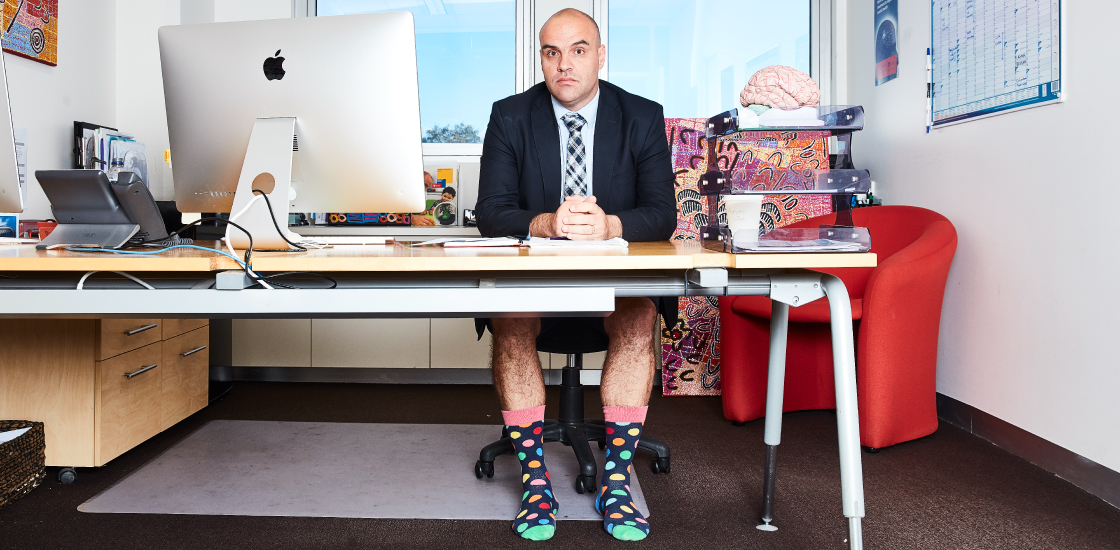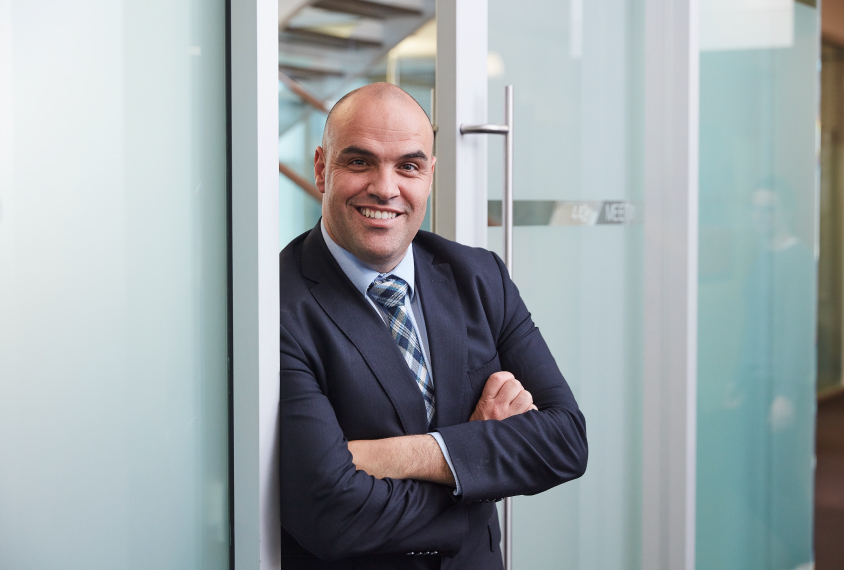Beyond the bench: A conversation with Adam Guastella
Clinical psychologist Adam Guastella is driven to develop treatments that work for all autistic people — and to throw birthday parties for a few of those people.

A typical day for Adam Guastella begins with a cat in his face and ends with wrestling his three sons, aged 6, 8 and 12 years.
In between, he might meet with autistic people in his clinic, scan their brains or coach them in managing their social anxiety.
As a professor and clinical psychologist at the University of Sydney, Guastella tests drug and behavioral therapies for autism and related conditions. He is also working on objective ways to assess those treatments.
He fuels these endeavors with black coffee and silence. He told Spectrum about his goals for mentoring students and how his pajama pants almost made it onto national television.
Spectrum: What big questions drive your research?
Adam Guastella: I feel driven to use personalized medicine to create tangible outcomes for autistic people and their caregivers. Our team tests new assessments and treatments for people with developmental and mental health conditions, and we work with our colleagues to do this at a national scale.
But we need to ensure our work has reach by including a diverse population. This can be a real challenge; many of the existing assessments have only been used in limited groups of people, such as those with relatively high cognitive ability. My colleagues and I often debate experimental designs, placebo effects, outcome measures and methods of treatment delivery.
S: Who inspires you?
AG: I often reflect on the late professor Penny J. Davis, an exceptionally bright Australian psychologist who worked on emotion processing. She was the first Australian woman appointed to Harvard University, as a lecturer in psychology. When she returned to Australia, she mentored students with immense passion. She regaled others, like me, with wonderful stories of science and its history. We would listen to her for hours on the lunch balcony and debate theories and propose models.
I share her stories with my own students and people who visit my clinic even now, some 15 years after she mentored me. Remembering her reminds me of how important it is to take the time to reflect, debate and share — something that can be hard to do in modern science.
S: What does your day look like?
AG: I usually wake up to a cat pawing at my face and children demanding breakfast. While I feed everyone, I scan my emails for anything urgent, then daydream my way to work — usually wearing bits of my breakfast.
Early morning is my most productive time, so I barricade myself in my office, writing and reviewing papers for an hour or two. I save committee meetings for the afternoon. This year has been a heavy grant-writing year, to build capacity for future research, but other years have been focused on publications. It’s a cycle.
My every day is a mix of tasks. I work with students, run clinical trials and lead a cognitive behavior program for adults with social anxiety. I’m working on developing objective measures of treatment success, which might include getting blood samples, scanning brains and even measuring people’s nasal cavities.
S: What is the most rewarding part of your job?
AG: I really, really love working with my autistic clients. They often view life in a unique way that surprises and teaches me. Some moments break your heart and warm it at the same time. The other day, one of the participants in my cognitive behavioral training program told me that he had always wanted a birthday party but had never had enough friends to invite. It just so happened that he was at our group program on his 18th birthday, so we all stayed around for a birthday celebration.
Honestly, I love most of my job — and I find that switching between so many seemingly disparate tasks helps me keep in mind the big picture of what I am trying to achieve and what really matters to autistic people.
S: Tell us your favorite story from a research conference.
AG: I was in New York for a conference on 2 April, World Autism Day, and while there I was asked to do an interview for a national television station back in Australia. I set up in my hotel room with my computer. Thinking the Skype camera would only capture my face and torso, I only dressed properly from the waist up. Five minutes before the live interview, the crew told me my room’s lighting didn’t work and that I would need to find somewhere else. Without thinking, I raced down to the reception desk in my business shirt, tie and pajama pants to explain my problem. The staff, stifling giggles, suggested the business center. In the middle of the interview, I was interrupted by a security guard. To cover me, the television station switched to music during the interruption. But this music stayed on my speakers, so I couldn’t hear the questions.
Needless to say, this was not my best interview. Of course, my mates in Australia thought it was absolutely hilarious and my phone started buzzing with messages. Luckily, my pajamas never made it on television.
S: Are you active on social media?
AG: I find Twitter to be a great way to access information that I would normally miss, and also to link with international colleagues. [You can follow Guastella at @Adam_Guastella.]
S: What do you eat or drink while working?
AG: I am very reliant on good coffee, which is one of the reasons I find it difficult to leave Australia for conferences. Most coffee shops in Australia deliver well-roasted, great coffee that’s not percolated. I was going crazy the last time I was in New York, and then I heard that there was a cafe run by Aussies that makes good coffee in lower Manhattan. My Aussie friends and I went there immediately, only to find many other Australians in this one coffee shop getting their hit.
S: How many unread emails are in your inbox right now?
AG: I have about 10,000 unread emails of spam, junk, any email starting with ‘Greetings,’ and any email from a frequent spammer called E. Padron. (Apologies to all the other E. Padrons out there who may deserve a real response). To the original E. Padron: I am not coming to your conferences, writing a follow-up to that obscure paper I published a decade ago or giving you contact information for my colleagues.
S: Does your lab have any traditions?
AG: I have a great team of students and staff, and we specialize in birthdays. Come visit us on your birthday. We will make you an epic cake and have the social anxiety cognitive behavioral training group sing birthday songs to you in public.

Recommended reading
Explore more from The Transmitter

Neuro’s ark: How goats can model neurodegeneration



